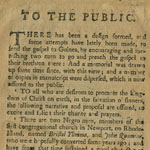 |
Ezra Stiles & Samuel Hopkins, To the Public (Newport, 1776).
Bristol Yamma and John Quamine, literate and converted slaves in Newport, purchased their freedom with lottery winnings and sought the aid of these two white clergymen to raise funds to become missionaries to western Africa under the auspices of the British Society for the Propagation of the Gospel in Foreign Parts. The British Society had native missionaries in place and one of them managed to put the Newport blacks in contact with their remaining family members, a rare feat. For these men, the return to African did mean a return home. |
The new British West African colony was created as a homeland for a cosmopolitan collection of blacks, including defeated Maroon warriors from Jamaica and St. Vincent, American blacks who had joined the British army, and blacks abandoned in England by West Indian masters. Hailed as a great humanitarian enterprise, it also meant that the British saw no place in their society for these displaced people. The colony became a refuge for Africans repatriated from the slave trade and an attraction to several African Americans, particularly the black seaman Paul Cuffe and his free black associates, several in Philadelphia. |
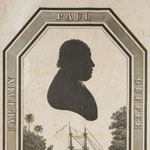
|
Lithograph in The Non-Slaveholder (Philadelphia, 1846). |
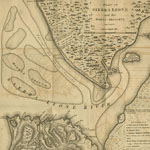 |
“Plan of Sierra Leone and the Parts Adjacent,” in Sierra Leone Company, An Account of the Colony of Sierra Leone, from Its First Establishment in 1793 (London, 1795). |
| |
|
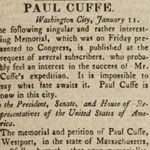
|
Paul Cuffe, “To the President, Senate, and House of Representatives of the United States of America,” in Poulson’s American Daily Advertiser, January 13, 1814.
Paul Cuffe was a free-born son of an African father and a Native American mother of New Bedford, who quickly made money as a seaman and was soon the owner of his own ships. Succeeding in the fishing industry, he ventured to Sierra Leone twice between 1810 and 1812 and conceived a plan to bring African Americans to help settle and Christianize the colony. His memorial to Congress for support of his enterprise, submitted during the war with Great Britain, failed, but more important were his contacts with African American businessmen and leaders, particularly the rich and influential Philadelphia sail maker James Forten, who supported the venture. Cuffe made one voyage with settlers in 1816 but died in 1817 before he could further his plan. |
![[Robert Finley,] Thoughts on the Colonization of Free Blacks (Washington, 1816).](images/section9/th12-5.jpg)
|
[Robert Finley,] Thoughts on the Colonization of Free Blacks (Washington, 1816).
This humble pamphlet published by a New Jersey clergyman near the end of 1816 launched a national organization of high-sounding purpose, the American Colonization Society, organized in 1817, to transport free blacks to the new territory of Liberia and emancipate slaves only on condition of their going as well. The Society enjoyed the support of such political notables as Henry Clay and Bushrod Washington and captivated white America. Society spokesmen sought contact with black leaders and, to their surprise, found them of another opinion. |
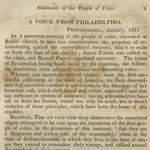 |
“A Voice from Philadelphia. Philadelphia, January, 1817,” in William Lloyd Garrison, Thoughts on African Colonization: Or an Impartial Exhibition of the Doctrines, Principles and Purposes of the American Colonization Society (Boston, 1831).
A mass meeting of some 3,000 black men, close to the entire black male population of Philadelphia, gathered at Bethel Church to consider the Colonization Society proposal. Though some leaders were mildly sympathetic, with thoughts of Paul Cuffe in mind, the gathering demanded of them a resounding renunciation of the plan. “Whereas our ancestors (not of choice) were the first successful cultivators of the wilds of America, we their descendants feel ourselves entitled to participate in the blessings of her luxuriant soil, which their blood and sweat manured.” They resented the Society’s contemptuous characterization of free blacks as useless and depraved and refused to separate themselves from their slave brethren. “We never will separate ourselves voluntarily from the slave population; they are our brethren by the ties of consanguinity, of suffering, and of wrong.”
The text shown here is from Garrison’s seminal essay marking the abolition movement’s declaration of war on the Colonization Society. Garrison included the Philadelphians’ statement along with those from black gatherings in eighteen other cities and towns. Black protest carried the day in antislavery ranks; the repudiation of colonization was their victory. |
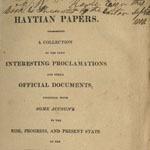 |
Prince Saunders, Haytian Papers. A Collection of the Interesting Proclamations and Other Official Documents, Together with Some Account of the Rise, Progress, and Present State of the Kingdom of Hayti (Boston, 1818).
Haiti was a magnet for many African Americans since becoming an independent black nation in 1805, and in 1818 reigning King Christophe sought help in developing the country by promoting the settlement of skilled black Americans. His agent, Prince Saunders of Boston, traveled to many black communities, particularly Philadelphia with its large population of black workers. This is one of his three publications here promoting African American emigration to Haiti. Though there was widespread interest, the plan collapsed with political instability in Haiti and the fall of Christophe. But Haiti was never far from the minds of black Americans, and these ideas would resurface in the near future. |
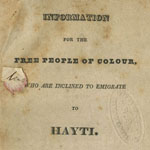 |
Society for Promoting the Emigration of Free Persons of Color to Hayti, Information for the Free People of Colour, Who Are Inclined to Emigrate to Hayti (New York, 1824). |
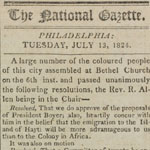 |
Announcement of a meeting of black Philadelphians on Haitian emigration, in The National Gazette, July 13, 1824.
Loring D. Dewey, the American Colonization Society agent in New York, heard black objections to Liberian colonization and respected emigration-minded blacks’ preference for Haiti. He established contact with the new President Jean-Pierre Boyer, who was interested in rekindling Christophe’s settlement scheme, and proposed a variety of incentives for American blacks with job skills to consider the move. Colonization Society officials were appalled. No white Americans in any official capacity wanted dealings with Haiti that might lead to recognition, and the Society’s many Southern supporters were horrified at the prospect of aiding a country founded by revolutionary slaves. But black Americans were very interested, and a lively movement developed. In this area alone, some two hundred blacks did indeed emigrate in 1825. Most would return, but a lively contingent of black Philadelphians stayed, and their descendants remain. |
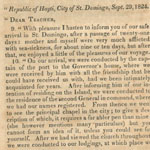 |
“Dear Teacher,” in Abigail Field Mott, Biographical Sketches and Interesting Anecdotes of Persons of Colour (New York, 1826).
Serena M. Baldwin and Charles W. Fisher of New York were two young emigrants to Haiti. Both attended the African Free School, sponsored by the New York Manumission Society. Included in Mott’s collection of brief works by and about blacks are their letters home. |
![Portrait of John Russwurm. From the Proceedings of the Quarto-Centennial of the African M.E. Church of South Carolina [Charleston ?, 1890].](images/section9/th12-11.jpg) |
Portrait of John Russwurm. From the Proceedings of the Quarto-Centennial of the African M.E. Church of South Carolina [Charleston ?, 1890]. |
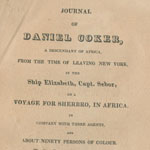 |
Daniel Coker, Journal of Daniel Coker, a Descendant of Africa, from the Time of Leaving New York in the Ship Elizabeth, Capt. Sebor, on a Voyage for Sherbro, in Africa, in Company with Three Agents and About Ninety Persons of Colour (Baltimore, 1820). Courtesy of the Historical Society of Pennsylvania.
The defection of talented African Americans like Baltimore’s Daniel Coker and John Russwurm of New York spoke to black leaders’ worst fears of the colonization movement, the draining off of black America’s best and brightest. Coker’s journal, which speaks of the happy Christian assembly of black colonists and white Colonization Society functionaries, was published by the Maryland Colonization Society as a promotional pamphlet. |
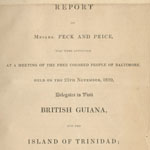 |
Nathaniel Peck & Thomas C. Price, Report of Messrs. Peck and Price, Who Were Appointed at a Meeting of the Free Colored People of Baltimore, Held on the 25th November, 1839, Delegates to Visit British Guiana, and the Island of Trinidad . . . (Baltimore, 1840).
Nathaniel Peck traveled to Liberia with Daniel Coker. Though he returned, the idea of emigration was never far from his and others minds. In 1839, as the delegate of the Baltimore Committee of Immigration, he and his colleague Thomas C. Price visited these two British colonies, now free of slavery, to determine the best site for blacks of Baltimore to resettle. |




![[Robert Finley,] Thoughts on the Colonization of Free Blacks (Washington, 1816).](images/section9/th12-5.jpg)





![Portrait of John Russwurm. From the Proceedings of the Quarto-Centennial of the African M.E. Church of South Carolina [Charleston ?, 1890].](images/section9/th12-11.jpg)

